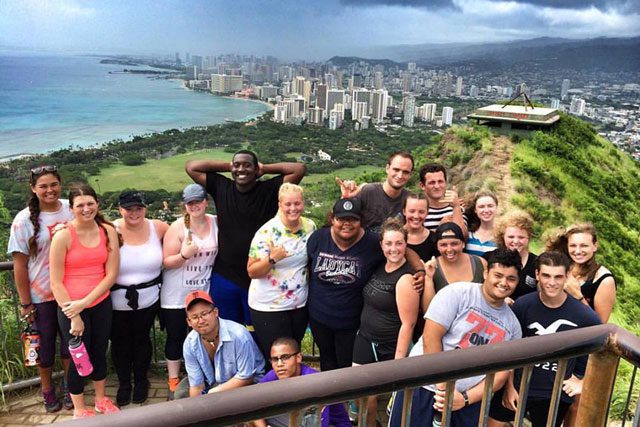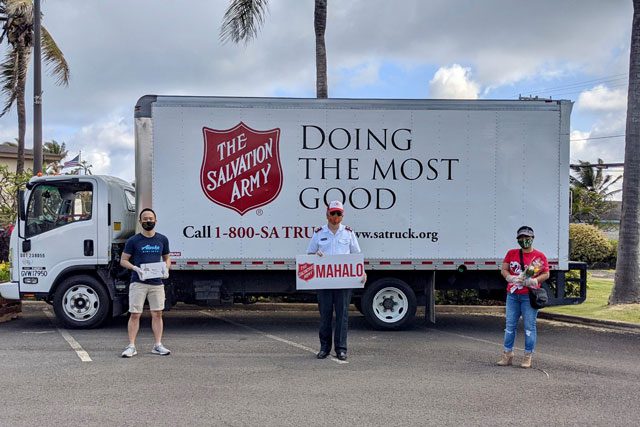“What would William Booth do?”
by Sue Schumann Warner –
With a catch in his voice, Kahului Corps Officer A/Captain Mark Merritt recalled his first intimate experience with homelessness, when he returned bell ringers to their living accommodations one night last winter. “It broke my heart,” he stated. “It was pouring rain, and I took one man back to a ditch, and another to a tree on the beach…and another to a gully in a cane field. That was where they lived.”
It was Merritt’s first Christmas in Kahului, and most of the bell ringers he hired were homeless and regulars at the corps’ Safe Haven drop-in center. Each morning during the holiday season the men arrived early at the corps to shower and clean up; they had a hot breakfast and were given a sack lunch before being taken to their posts. Before starting their day, they had devotions—“The most important part of our morning together,” Merritt said.
He emphasized to them that their job was important, and that they should be polite and courteous to all who passed by, and wish them a Merry Christmas with a smile—whether or not they contributed to the kettles.
In turn, the men—fueled by the substantial meal, clean clothes, and the esteem with which they were treated—responded by working hard: that Christmas, kettle revenue was up 47 percent from the previous year.
But the specter of the men’s circumstances—living outdoors in bushes, trees, and gullies—haunted him. “What would William Booth do?” he asked himself. “I struggled with that.”
B.E.D.S. is born
One night, after tossing and turning in bed, he thought “What if….” and came up with a plan. “We have a small corps building, with a chapel that seats around 80 people and a fellowship hall that can accommodate 50-60. No one is here after 9 p.m.,” he stated. “I figured we could get cots and house 15 men per night in the fellowship hall.”
And so the Booth Emergency Drop-in Shelter (B.E.D.S.) was born.
A 10-week pilot program, which started in February, proved the idea successful. The men arrived at 8 p.m. at the Safe Haven, located next door on the corps’ property, where they checked in, could watch TV, shower and clean up. At 9 p.m. they set up cots in the corps’ fellowship hall and lights were off at 9:30. A night manager was on site to oversee the program. At 5:30 a.m. it was time to rise, and by 7 a.m. the men had put the cots away, cleaned the bathrooms, and were gone.
“You never knew they were here,” Merritt says. “This provided a clean, safe place for them—and by the end of the program, 12 had jobs and four had permanent housing. These are not bums—they are guys that are having a hard time.’
After working with divisional and territorial headquarters to receive funding for the program, which costs approximately $40,000 to run for the year, BEDS has become a successful venture that is recognized by the community: the Homeless Alliance Continuum has asked the Army to train others to establish the same type of program at other churches.
Now, more than 100 men have participated in the program, and 20% have obtained some form of housing, noted Merritt.
New corps officers
While A/Captains Mark and Kathy Merritt are new corps officers—they came to this appointment, their first, in June 2007—both have skills and experience that serve them well: Mark had been an ordained Presbyterian minister for 14 years, and had recently assisted at the Kauluwela Mission Corps in Oahu. Kathy had worked at divisional headquarters (DHQ) in Kansas City, and had been an accounting supervisor at Hawaii DHQ for 10 years.
They arrived with a mandate to get the corps squared-away financially: it had a $760,000 debt to divisional headquarters. In October 2007 they proposed a three-year plan to divisional finance council that would eradicate the debt; thanks to generous donations, matching funds and careful planning, with strategic cuts in the corps’ budget—and no cuts to programs—on January 2, 2008 the debt was paid off. “It was a miracle,” Merritt says.
The corps runs a full range of Salvation Army programs, from Women’s Ministries to youth, and men’s and family programs. Sunday services are now attended by 75-80, and the youth programs have grown from 12 to 65-70. Youth activities include Rangers, Adventure Corps, Moonbeams, Sunbeams, Girl Guards, Corps Cadets, and Young People’s League. Quite a few of the children come from poor homes.
The homeless are integrated into the corps, attending worship services, Bible studies and other programs. They are served even in death; during the past seven years, 82 homeless persons who received assistance in some form from Army ministry have died and many were given funerals at the corps.
Plans for corps and homeless ministry
The corps has recently started raising funds to build a multipurpose chapel/youth center, which will seat around 200 people for worship and then be used for youth activities during the week. It will also have a commercial kitchen, four classrooms, and some office space.
When the building is completed, the Safe Haven program will be moved from the tent at the back of the property to the existing building, which would then house the complete homeless ministry: Safe Haven, BEDS, social services, offices, kitchen, and lunch room.
“The beauty of this plan is that we will have a chapel of sufficient space in which to grow our corps and our youth programs, and the existing building will fit the homeless ministry nicely,” Merritt said. “It will allow us to continue our plans for a larger BEDS program and an offshoot program of a ‘workingman’s dorm.’ We could house about 60-70 clients in our existing building with only the added expense of putting in several showers.”
According to Merritt, the dorm would provide housing for men with proven work records who are trying to better their situations. They would have the option of staying for six months to a year, in a dorm-like setting with two men in each cubicle.
It’s a good plan…and sounds like something William Booth might do.












